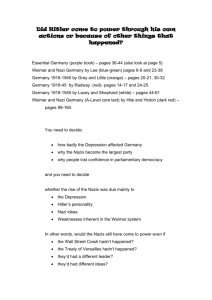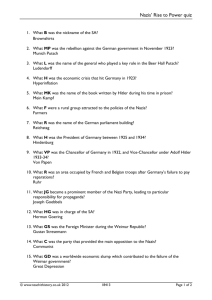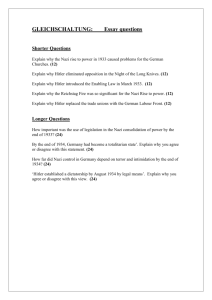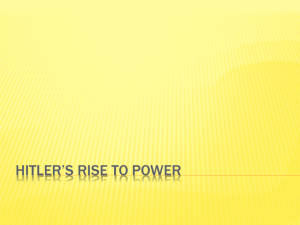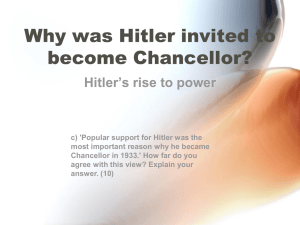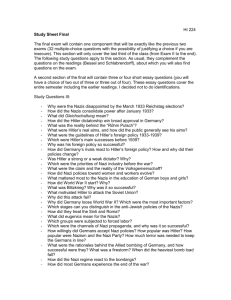Document
advertisement
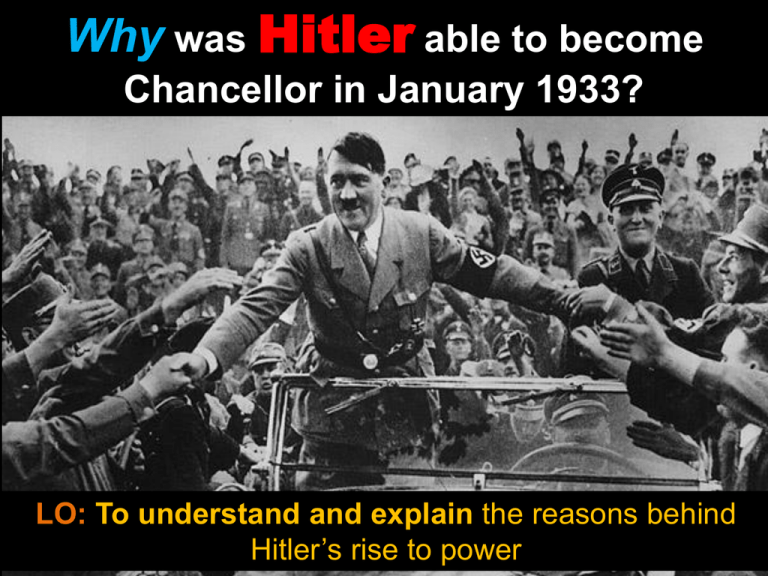
Why was Hitler able to become Chancellor in January 1933? LO: To understand and explain the reasons behind Hitler’s rise to power STARTER – back of books: Name these three central characters from the Weimar Germany unit and give two facts about each. STARTER – back of books: Name these three central characters from the Weimar Germany unit and give two facts about each. Friedrich Ebert Gustav Stresemann Anton Drexler How did the Wall Street Crash increase support for the Nazis? • In October 1929, share prices fell dramatically on the Wall Street stock exchange in New York. Falling shares meant people’s investments fell. • People rushed to sell shares before they fell further. • On ‘Black Thursday’, 24th October 1929, 13 million shares were sold. Shares worth $20,000 in the morning were worth $1000 by the end of the day. Economic Effects • German banks were major investors in US shares and suffered huge losses. People rushed to withdraw money from banks. • German and US banks recalled all money leant to businesses. German companies were dependent on US and German loans. Businesses closed or slowed down = fall in industrial output and rise in unemployment. • Also a disaster for export industries and domestic demand fell too = further rise in unemployment. Depression in Germany http://www.youtube.com/watch?v=1dDfVwzJbW4&feature=related TASKS: 1. How many unemployed were there in 1932? 2. What proportion of the working population were unemployed in 1932? 3. Explain the correlation between the unemployment rate and the electoral results of the Nazi party 4. What does this evidence suggest about the link between economic depression and political extremism? Social and Political Effects • Economic collapsed caused: • Middle classes lost savings, their companies and homes. • Workers became unemployed. • The Weimar government led by Chancellor Heinrich Bruning (1930-1932) proposed: • Raising taxes to pay the cost of unemployment benefit • Reducing unemployment benefit to make payments more affordable Social and Political Effects • This pleased no one. The middle and upper classes, represented by Right-wing parties opposed higher taxes. • Left-wing parties and working class opposed lower benefits. • Bruning’s coalition of parties collapsed in 1930 so he had to rely on Article 48. • 5 Presidential Decrees in 1930 • 44 Decrees in 1931 • 66 in 1932 Who voted Nazi? • The failure of Chancellor Bruning to solve the crisis meant that voters increasingly turned to extreme-right wing and left-wing parties to solve their problems. Seats in Reichstag May 1928 Sep 1930 July 1932 National Socialist 12 107 230 Communists 54 77 89 Votes for Nazis 1m 6m 13 m Many different groups of people supported • Nazi support rose during this the Nazis. Copy and time, partly because the Nazis complete the table on had very effective your hand-outs with campaigning techniques and because they appealed to all the information from Germans. the slides. Hitler’s Appeal • His personal appeal was universal. Played a central role in propaganda material and appeared everywhere. • Used aeroplanes to campaign everywhere in 1930 and 1932. • Germans believed he could: • • • • Unite the country/Strong leader Restore order from social unrest Scrap the Treaty of Versailles Persuade other nations to treat Germany fairly The Strength of the SA • SA was vital to Nazi election campaigns. 400,000 Storm Troopers by 1930. • Used to make party seem strong, organised, disciplined and reliable. • Also used to harass opposition parties, break into their offices and disrupt their rallies. Working-class support • Working class people were attracted by Nazi support for traditional German values. • Nazi propaganda promised ‘Work and Bread’ – called themselves the National Socialist German Workers Party but the Nazis never dominated the working class. • Most workers supported the communists. Middle-class support • Professionals, teachers, lawyers, business people and small farmers often owned land and businesses and had savings. • Depression hurt middle classes who lost savings and pensions. • Hitler was seen as a strong leader who would help the economic recovery. Middle-class support • Middle class was also afraid of the Communist Party (KPD) who promised to abolish private ownership of land and businesses. Nazi’s were anti-communist. • Nazi’s were also opposed to the perceived moral decline under Weimar i.e. drinking, sex, nightclubs. Middle class liked traditional German values. Farmers • The Nazi’s renewed their focus on farmers in 1928 by getting rid of their promise to confiscate all private land. • Private land would only be confiscated if Jewish owned. • Hitler promised to protect farmers from the Communists. • Emphasis on ‘autarky’ would benefit farmers financially. Big business • Business classes usually supported the right-wing National Party but the party’s support halved from 19291932. Blamed for Depression. • The Nazi’s were now the biggest right-wing party who promised to stop communism. • Support boosted funds and helped spread media message through newspaper owners like Alfred Hugenberg. Young People and Women • Hitler’s anger against the system, passionate speeches, ambitions for the future and atmosphere of Nazi rallies attracted young people. • Women were opposed to the Nazi view of women as housewives. • Some women were attracted to the idea of strong families and a strong Germany. How did Hitler become Chancellor in January 1933? • In March 1932, Hitler stood for election as president but failed. Despite being the biggest party, Hindenburg refused to make Hitler Chancellor. • From March 1932 – January 1933, Hitler managed to negotiate his way into power. But how did he do this? Reaction of the Weimar Republic Indecision • Parliament – Proportional Representation: The electoral system meant that Reichstag seats were split between many parties. No party could get a majority, so weak, indecisive coalition governments were formed. • President – Article 48: The President had emergency powers, but his advisers discouraged him from raising unemployment benefits, fearing another hyperinflation crisis like in 1923. Reaction of the Weimar Republic Miscalculation • As well as pursuing unpopular policies, the Weimar Republic made a terrible mistake in appointing Hitler as Chancellor in January 1933 – even though he made it clear he hated democracy. • What makes this decision even more surprising is that: • Support for the Nazi Party was declining • Germany was coming out of the Depression • President Hindenburg had nothing but contempt for Hitler (a little Bohemian corporal) 1932-33: The ‘Backstairs Intrigue’ • June 1932 – Hindenburg sacks his Chancellor, Bruning, and appoints his unpopular friend, Franz von Papen, in his place. Creates tension. • July 1932 – Elections. Nazis win 230 seats. Become largest party. Hitler demands to become Chancellor. Hindenburg refuses. He allows Papen to carry on, getting his measures passed by Article 48. • Nov 1932 – Elections. Hindenburg replaces Papen as Chancellor with Schleicher, but Papen remains a close advisor. Nazis still largest party although they lose 34 seats as depression starts to fade. 1932-33: The ‘Backstairs Intrigue’ • Dec 1932 – Schleicher resigns. He had no support in Reichstag, and is fed up of being Papen’s mouthpiece. • Jan 1933 – Hindenburg is desperate to appoint a Chancellor who has Reichstag support, and avoid the possibility of violence from the SA. Hitler is therefore appointed with Papen as vice chancellor. They felt Hitler can be controlled in a coalition. They were wrong. Why was Hitler appointed chancellor? 24 of 10 © Boardworks Ltd 2009 W h y was Hitler able to become Chancellor of Germany in January 1933? http://www.yo utube.com/w atch?v=mTuI zGe2Nz8 Write an extended answer to this question. Refer to worksheet & Include in your answer: • The effects of the Wall Street Crash on different groups of people in Germany • what the Nazis said to get support • How the Nazis got their message across • The steps to power between 1930 and January 1933, including the role of Hindenburg. 25 of 10 © Boardworks Ltd 2009
